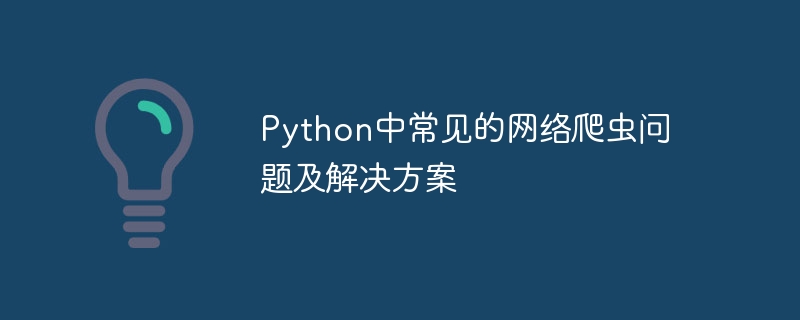Python中常見的網路爬蟲問題及解決方案
- WBOYWBOYWBOYWBOYWBOYWBOYWBOYWBOYWBOYWBOYWBOYWBOYWB原創
- 2023-10-09 21:03:201414瀏覽

Python中常見的網路爬蟲問題及解決方案
概述:
隨著網路的發展,網路爬蟲已成為資料收集和資訊分析的重要工具。而Python作為一種簡單易用且功能強大的程式語言,被廣泛應用於網路爬蟲的開發。然而,在實際開發過程中,我們常常會遇到一些問題。本文將介紹Python中常見的網路爬蟲問題,並提供相應的解決方案,同時附上程式碼範例。
一、反爬蟲策略
反爬蟲是指網站為了保護自身利益,採取一系列措施限制爬蟲對網站的存取。常見的反爬蟲策略包括IP封鎖、驗證碼、登入限制等。以下是一些解決方案:
- 使用代理IP
反爬蟲常透過IP位址進行識別和封鎖,因此我們可以透過代理伺服器取得不同的IP位址來規避反爬蟲策略。以下是一個使用代理IP的範例程式碼:
import requests
def get_html(url):
proxy = {
'http': 'http://username:password@proxy_ip:proxy_port',
'https': 'https://username:password@proxy_ip:proxy_port'
}
headers = {
'User-Agent': 'Mozilla/5.0 (Windows NT 10.0; Win64; x64) AppleWebKit/537.36 (KHTML, like Gecko) Chrome/71.0.3578.98 Safari/537.36'
}
try:
response = requests.get(url, proxies=proxy, headers=headers)
if response.status_code == 200:
return response.text
else:
return None
except requests.exceptions.RequestException as e:
return None
url = 'http://example.com'
html = get_html(url)- 使用隨機User-Agent頭
反爬蟲可能透過偵測User-Agent頭來辨識爬蟲存取。我們可以使用隨機的User-Agent頭來規避該策略。以下是使用隨機User-Agent頭的範例程式碼:
import requests
import random
def get_html(url):
user_agents = [
'Mozilla/5.0 (Windows NT 10.0; Win64; x64) AppleWebKit/537.36 (KHTML, like Gecko) Chrome/71.0.3578.98 Safari/537.36',
'Mozilla/5.0 (Macintosh; Intel Mac OS X 10_14_3) AppleWebKit/537.36 (KHTML, like Gecko) Chrome/71.0.3578.98 Safari/537.36',
'Mozilla/5.0 (X11; Linux x86_64) AppleWebKit/537.36 (KHTML, like Gecko) Chrome/71.0.3578.98 Safari/537.36'
]
headers = {
'User-Agent': random.choice(user_agents)
}
try:
response = requests.get(url, headers=headers)
if response.status_code == 200:
return response.text
else:
return None
except requests.exceptions.RequestException as e:
return None
url = 'http://example.com'
html = get_html(url)二、頁面解析
在爬取資料時,我們常需要對頁面進行解析,擷取所需的訊息。以下是一些常見的頁面解析問題及對應的解決方案:
- 靜態頁面解析
對於靜態頁面,我們可以使用Python中的一些函式庫,如BeautifulSoup、XPath等,來進行解析。以下是使用BeautifulSoup進行解析的範例程式碼:
import requests
from bs4 import BeautifulSoup
def get_html(url):
headers = {
'User-Agent': 'Mozilla/5.0 (Windows NT 10.0; Win64; x64) AppleWebKit/537.36 (KHTML, like Gecko) Chrome/71.0.3578.98 Safari/537.36'
}
try:
response = requests.get(url, headers=headers)
if response.status_code == 200:
return response.text
else:
return None
except requests.exceptions.RequestException as e:
return None
def get_info(html):
soup = BeautifulSoup(html, 'html.parser')
title = soup.title.text
return title
url = 'http://example.com'
html = get_html(url)
info = get_info(html)- 動態頁面解析
針對使用JavaScript渲染的動態頁面,我們可以使用Selenium函式庫來模擬瀏覽器行為,獲取渲染後的頁面。以下是使用Selenium進行動態頁面解析的範例程式碼:
from selenium import webdriver
def get_html(url):
driver = webdriver.Chrome('path/to/chromedriver')
driver.get(url)
html = driver.page_source
return html
def get_info(html):
# 解析获取所需信息
pass
url = 'http://example.com'
html = get_html(url)
info = get_info(html)以上是Python中常見的網路爬蟲問題及解決方案的概述。在實際開發過程中,根據不同的場景,可能會遇到更多的問題。希望本文能為讀者在網路爬蟲開發上提供一些參考與幫助。
以上是Python中常見的網路爬蟲問題及解決方案的詳細內容。更多資訊請關注PHP中文網其他相關文章!
陳述:
本文內容由網友自願投稿,版權歸原作者所有。本站不承擔相應的法律責任。如發現涉嫌抄襲或侵權的內容,請聯絡admin@php.cn

